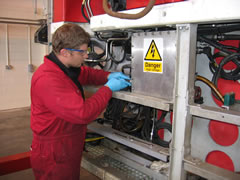About the Course
This course is aimed at personnel working in the ROV industry who are required to implement safe systems of work when maintaining High Voltage systems.
The course has been designed to develop and assess the knowlege of personnel, prior to practical skills assessment.
Practical assessment may be conducted by an approved Exa-Blue Trainning Center skills assessor.
This course is aimed at personnel working in the ROV industry who are required to implement safe systems of work when maintaining High Voltage systems. .
The course incorporates the guidelines issued by IMCA in guidance documents “R005: Safety Procedures for Working on High Voltage Equipment” and “R015/D045: Code of Practice for the Safe Use of Electricity Underwater”.
It is intended that delegates will reflect on their own experience of ROV maintenance activities.
They will then use the information contained in the course to improve on any safety measures that are required to be in place prior to carrying out the work.
As a delegate you are encouraged to make reference to your own company’s policies and procedures that relate to High Voltage Safety.
You may also draw on the experience of other members of your ROV team to help you identify what is safe working practice.
The multiple choice exam will test your knowledge of all the course sessions.
REMEMBER: UNDER NO CIRCUMSTANCES MUST YOU WORK ON LIFE HIGH VOLTAGE EQUIPMENT

Curriculum
- 7 Sections
- 53 Lessons
- 4 Days
Expand all sectionsCollapse all sections
- Definitions6
- Module 01 (Safety with High Voltage)Learning Outcomes Discuss the Safety Legislation that applies to High Voltage systems and how it determines how we carry out maintenance activities on ROV systems Define your own responsibilities and those of colleagues when working on High Voltage systems Discuss the Norwegian perspective to High Voltage Safety Awareness and associated maintenance activities Identify what is considered to be Safe Working Practice when carrying out electrical maintenance activities Introduce the concept of Risk Assessment that must be undertaken prior to carrying out maintenance activities13
- 2.0Attitudes towards Safety
- 2.1The Safety Culture
- 2.2Safety Legislation
- 2.3Approved Codes of Practice (ACOPS)
- 2.4Responsibilities
- 2.5Personnel Requirements
- 2.6Key Personnel Roles
- 2.7The Norwegian Safety Environment
- 2.8Safe Working Practice
- 2.9Personal Protective Equipment (PPE)
- 2.10The Management of Health And Safety At Work
- 2.11Risk Assessment
- 2.12QUIZ 0113 Questions
- Module 02 (System Components)Learning Outcomes Revise some key theoretical concepts that pertain to High Voltage Systems. Identify the key components in a typical ROV system that relate to the High Voltage circuitry. Discuss the operation of components in a typical ROV system that relate to the High Voltage circuitry. Outline any operational and maintenance tasks that may be required on High Voltage system components.13
- 3.0Theoretical Concepts Relating to High Voltage Electricity
- 3.1Isolation Transformers
- 3.2Power Distribution Units
- 3.3Contactors, Circuit Breakers And Control Relays
- 3.4Monitoring Equipment (Volt Meters, Current Meters etc.)
- 3.5Surface Junction Box
- 3.6Slip Rings
- 3.7ROV Junction Box
- 3.8Transformers
- 3.9Cables And Glands
- 3.10Protection Devices
- 3.11Soft Starts
- 3.12QUIZ 0222 Questions
- Module 03 (Risk & Injury)It should be noted that this course does not replace the formal first aid courses that are carried out as part of the offshore survival courses. This course merely provides an overview of first aid techniques and further guidance should be sought from qualified medical personnel. YOU ARE NOT DEEMED A COMPETENT FIRST AIDER AS A RESULT OF TAKING THIS COURSE! Learning Outcomes Explain how the human body is affected by electricity Explain how electrical burns originate Provide an overview of the first aid techniques for the treatment of injuries caused by electricity7
- Module 04 (Safe Systems of Work)Learning Outcomes Examine the key concepts that must be considered to protect us from electric shock Identify what is considered to be 'Safe Working Practice' when working with electrical systems Identify the key steps to follow when carrying out the isolation of High Voltage equipment prior to performing maintenance activities9
- Module 05 (Hazardous Areas)Learning Outcomes Identify what a hazardous area is and how it can affect ROV operating and maintenance procedures Introduce the types of protection available for equipment used in hazardous areas Discuss how equipment is labelled for use in hazardous areas Maintenance on Ex equipment should only be conducted by a trained and competent electrical engineer. This course is not designed to infer competence in this specific area.9
- 6.0What Constitutes A Hazardous And Safe Area
- 6.1How The Zoning System Applies to The ROV Industry
- 6.2Overview of The Atex Directive
- 6.3The Types of ‘Ex’ Protection
- 6.4Equipment Used In Hazardous Areas
- 6.5The Principles of Intrinsic Safety And The Meaning of ‘ia’ And ‘ib’
- 6.6The Meaning of Gas Groups, Temperature Ratings And IP Classification
- 6.7The Labelling of ‘Ex’ Equipment
- 6.8QUIZ 0515 Questions
- Final Exam2
